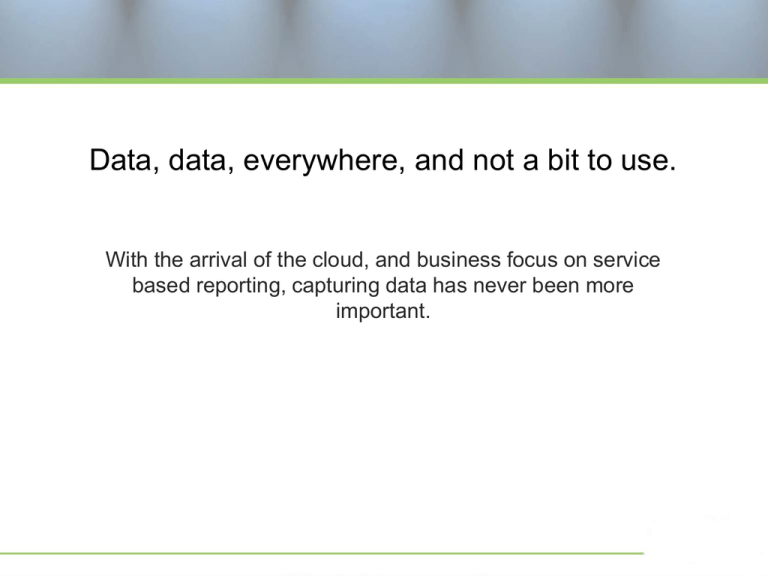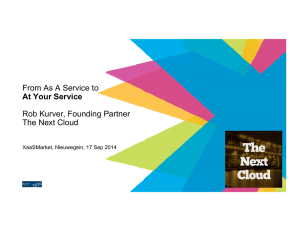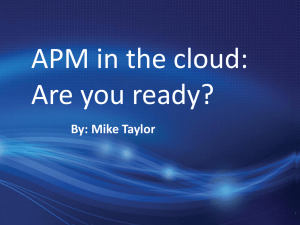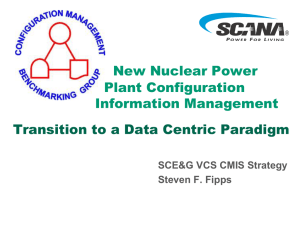Data: How, What, and Why
advertisement

Data, data, everywhere, and not a bit to use. With the arrival of the cloud, and business focus on service based reporting, capturing data has never been more important. This is not a presentation about Big Data • Big Data is a separate topic about new ways to store and retrieve very large amounts of data that exceed constraints of traditional data management systems. Session Agenda • • • • • • • • • Why Talk about data? Business demands My basic principles Data Capture Techniques Data Sources The Obligatory Cloud Part APM CMIS Reality Why talk about data? • • • • • • • Dashboard, Dashboard, Dashboard Alerts Automation CMIS What does that all sit on? Raw data Ever increasing number of requests to take data from an ever increasing number of sources Frustration A Problem Shared • • • Data you want Cool data you got hold of Solutions you found • Write them down, scrunch it up, and throw them up the front here. • Put your name on it • No prizes for hitting the presenter • Or just ask later Session Agenda • • • • • • • • • Why Talk about data? Business demands My basic principles Data Capture Techniques Data Sources The Obligatory Cloud Part APM CMIS Reality What businesses are asking for • Have data for everything • Internal to a system • Across all infrastructure (build a service picture) • Business volumes & transaction response times • Don’t deploy more agents • Ensure reliable data • Minimal Storage • No staff Where a lot of people are • A handful of tools for specific platforms • Designed for sys admin roles • No single person can access them all • No business data • Projections based on resource utilisations • Huge volumes of “out of reach” data • Some Agents, some SNMP capture, some stuff nobody understands anymore • Limited staff Session Agenda • • • • • • • • • Why Talk about data? Business demands My basic principles Data Capture Techniques Data Sources The Obligatory Cloud Part APM CMIS Reality Data Capture (My Basic Principals) • More is (just this once), more • At data capture time get everything you will need • Time travel is still fiction • Quality is important • Put it under YOUR control • Full service picture • • • • • Resource Application Network SAN Business data Session Agenda • • • • • • • • • Why Talk about data? Business demands My basic principles Data Capture Techniques Data Sources The Obligatory Cloud Part APM CMIS Reality Capture Techniques • Agentless (SNMP, WMI, etc) • • • • • Is subject to more security issues, and network quality. Broken communication = lost data Easier/Faster implementation (often), Less data of lower quality Agent Based • Autonomous • Data collected by a local process. If the server is up, data capture is running. • Broken communication = catch up later • Possibility to use existing Agents • Overhead (system and human) • • Vote now! Blended Delivery Model • Where most people are. Session Agenda • • • • • • • • • Why Talk about data? Business demands My basic principles Data Capture Techniques Data Sources The Obligatory Cloud Part APM CMIS Reality Application/Service Data • Databases • Well thought out APIs or Windows Counters • Well thought out Agents do this • SAP • Various transactions return Perf data (e.g. ST03) • What if there is no designed interface? • Logs, databases, write your own instrumentation • APM Tools Business/Application Transaction data (APM) • A user action = A transaction • Log on, Search, Add to Basket, Checkout, Payment = 5 transactions • Benefits • • • • • Common language Service based Defined SLAs Real workload volumes (Planning benefits) Usual Difficulties • No tool capturing this data (Ask me for a recommendation) • No access to the data held (Typically controlled by Operations) • No import facility to capacity tool • Avoid • Exporting data from both tools into Excel and manually cutting and pasting to get combined reports SANs • Challenge • IOPS remains the biggest bottleneck • Surprising number of capacity managers are unaware of storage capacity available • Where to get data • SMI-S (Storage Management Initiative – Standard) • PowerShell Plugins • Learn PowerShell or learn to serve fries (some dude 2008) • Storage Vendor central control server • Operations Manager, StorageWorks, ControlCenter • Using the data? • Bring it into your capacity tool In the last 6 months • • • • • • Business / Customer transaction reports (multiple types) Open VMS T4 data Historical CPU & Memory data from home grown scripts NetApp, HP EVA IP Pool allocation Datacenter temperature & power More detailed example • NetApp • Operations Manager DFM CLI Export • Occupancy and performance data for all LUNS, Volumes, Aggregates & Systems connected to Operations Manager. • dfm data export run –d comma –t “5 mins” –f avg –h “1 day” • Database tables in .csv • Script to produce something “nicer” to import Session Agenda • • • • • • • • • Why Talk about data? Business demands My basic principles Data Capture Techniques Data Sources The Obligatory Cloud Part APM CMIS Reality The Cloud http://xkcd.com/908/ Basic Cloud Types & Challenges (IaaS) • Public Cloud (Worst Case) • • • • Private Cloud (Best Case) • • • Full control You are responsible, but have all the data Community Cloud (Never seen) • • • No control You put your faith in the provider Monitor response times only? Potential control You are involved and may have access to the data Hybrid Cloud (Where you’re likely to be) • • Some control Full control of the Private Cloud portion only Want to Benchmark the Public cloud? • • “How hard can it be” Jeremy Clarkson Get a VM up and running and see what workload it can handle • AWS results all over the place • Somebody else must have looked into this: • http://www.spec.org/osgcloud/ • Still working on it…. • Join in ? (I’m short of the $10,000 required…) • http://datasys.cs.iit.edu/events/MTAGS12/i02.pdf • IaaS Cloud Benchmarking: Approaches, Challenges, and Experience • Alexandru Iosup, Radu Prodan, and Dick Epema Benchmarking the Cloud problems • Cloud evolution • Changes made under your feet • We are no longer in the loop “commercial clouds such as Amazon EC2 add frequently new functionality to their systems. Thus, the benchmarking results obtained at any given time may be unrepresentative for the future behaviour of the system.” Alexandru Iosup, Radu Prodan, and Dick Epema • So why don’t we continually benchmark the cloud? • Because it’s complex and expensive (Challenge 1 = how to do it cheap) “A straightforward approach to benchmark both short-term dynamics and long-term evolution is to measure the system under test periodically, with judiciously chosen frequencies [26]. However, this approach increases the pressure of the so-far unresolved Challenge 1.” Alexandru Iosup, Radu Prodan, and Dick Epema Benchmarking (more problems) • Even with lots of data, you’ll have a hard time making it fit reality because you cannot replicate all the software involved. “We have surveyed in our previous work [26], [27] over ten performance studies that use common benchmarks to assess the virtualization overhead on computation (5–15%), I/O (10–30%), and HPC kernels (results vary). We have shown in a recent study of four commercial IaaS clouds [27] that virtualized resources obtained from public clouds can have a much lower performance than the theoretical peak, possibly because of the performance of the middleware layer.” Alexandru Iosup, Radu Prodan, and Dick Epema Long term observation “We have observed the long-term evolution in performance of clouds since 2007. Then, the acquisition of one EC2 cloud resource took an average time of 50 seconds, and constantly increased to 64 seconds in 2008 and 78 seconds in 2009. The EU S3 service shows pronounced daily patterns with lower transfer rates during night hours (7PM to 2AM), while the US S3 service exhibits a yearly pattern with lowest mean performance during the months January, September, and October. Other services have occasional decreases in performance, such as SDB in March 2009, which later steadily recovered until December [26].” Alexandru Iosup, Radu Prodan, and Dick Epema Final nail in the coffin “Depending on the provider and its middleware abstraction, several cloud overheads and performance metrics can have different interpretation and meaning.” Alexandru Iosup, Radu Prodan, and Dick Epema • • So you can’t trust the data from clouds to be what you expect. And you can’t trust your existing benchmarks to represent the future. • So…what can you do? Private Cloud • You are in charge and you monitor the hardware utilisations • The Cloud still has physical limits, and soft “limits” • • Resource Pools, Reservations etc Opportunity • Resource Utilisation and Service Information combined • Users, Processes, Transactions, Business Volumes • Challenge • Business decision based on easy capacity monitoring? Session Agenda • • • • • • • • Why Talk about data? Business demands My basic principles Data Capture Techniques Data Sources The Obligatory Cloud Part APM Reality APM • • • • • Transaction times Transaction counts Transaction type End to end Per server • All that information you could never get from the business, in one handy location Combine APM & Resource Data Session Agenda • • • • • • • • • Why Talk about data? Business demands My basic principles Data Capture Techniques Data Sources The Obligatory Cloud Part APM CMIS Reality CMIS DB1 DB3 DB2 DB4 CMIS DB CMIS • Centralise • A single interface to all data • Organise it • Mirror the organisation • Automate • Computers are great at performing repetitive tasks. Use them. Session Agenda • • • • • • • • • Why Talk about data? Business demands My basic principles Data Capture Techniques Data Sources The Obligatory Cloud Part APM CMIS Reality In reality how do people get data? • From other internal teams • Process and reprimands • From the outsourcer • Contract • Enforce it • The 1st rule of data club: • Data supplier uses their own tools • Requires: • Sponsor with teeth So what conclusions do I draw? • Be flexible • You will have to take the data from whatever already exists • Stand Your Ground • Don’t make work for yourself (You don’t have the staff) • They deliver the data, you keep it. • Introduce APM/BTM tools • The typical missing element • Centralise the data at capture time • Know your cloud strategy and get in early with requirements Audience Participation & Questions







